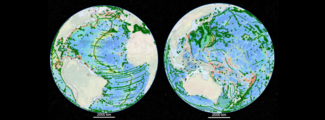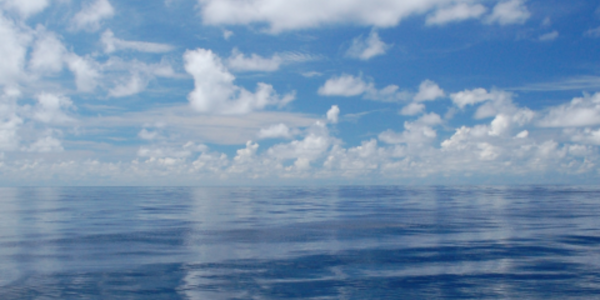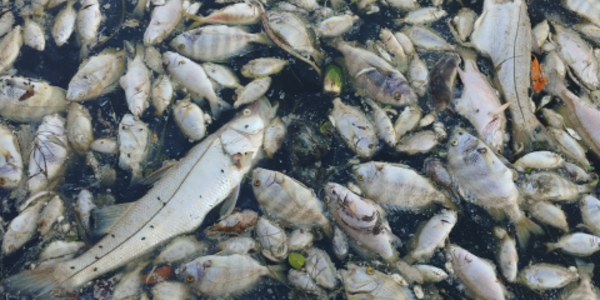Multinational effort supports a tool to search the contours of the seafloor

As ships and ocean observers criss-cross the globe to study undersea terrain, a gazetteer of place names highlights tracks the growing knowledge of the ocean floor. In an effort at standardization, hydrographers, research institutes, governments, and others from the global maritime community utilize an NCEI-built tool to sort, name, and reference historic and newly discovered places on the ocean floor.
The GEBCO Undersea Feature Names Gazetteer, hosted online by the International Hydrographic Organization’s Data Center for Digital Bathymetry (IHO DCDB), co-located with NCEI, allows the public to search for, view, and download information about more than 4,500 undersea features. The public can find information including geographic location, feature dimensions, the discoverer, and the origin of the name. The tool simplifies tracking so that if a place has already secured a name or has been christened by a discoverer, duplication in naming is less likely. The Gazetteer also reduces misidentification.
From mud volcanoes to reefs, the Gazetteer uses several criteria for browsing seafloor features throughout the ocean worldwide. Users can search for locations with a few dropdown menus and a world map. Dropdown menus filter for feature type (reef, barrier, seamount, or more than 100 others), by discoverer, and by feature name, if available.
Newly identified ocean features, primarily those outside territorial waters, are submitted for naming through the GEBCO Sub-Committee on Undersea Feature Names (SCUFN). The Gazetteer contributes to streamlining the naming process by giving accurate, up-to-date listings that improve the quality of information about the ocean floor. The Gazetteer is then updated annually to accurately represent the committee’s most recent decisions.
Development of the Naming Gazetteer
Almost a decade ago, a multinational group of hydrographers and Earth scientists affiliated with a group dedicated to mapping oceans, under the name General Bathymetric Chart of the Oceans (GEBCO), envisioned a digital Gazetteer. They saw a need to keep up with the growing details about the features below the surface, especially newfound ones beyond territorial boundaries. At first, a paper Gazetteer was produced annually and evolved with NOAA’s support into today’s digital version.
Ships that survey the oceans continue to improve the picture of the seafloor, exacerbating an existing problem of sorting the information. GEBCO members advanced the idea of a digital Gazetteer because newer mapping technologies have vastly improved the resolution of the sea bottom. According to authors of a scientific article about the Gazetteer published in the open access journal Earth & Space Science News, the level of detail is such that “some features only tens of meters in relief are now being mapped and named.”
Technologies, such as multibeam sonar, remotely operated underwater vehicles, and autonomous underwater vehicles, are expanding the knowledge base—and confusion. Previously, informal names used repeatedly over a period of decades have been incorporated into maps and scientific papers. One name might also be applied to several different features, or a single feature could be named independently by different groups, resulting in several different informal names. Occasionally, this has led to misidentification and disagreement.
Gazetteer Gives Clearer History
History can be found on the Gazetteer. Not all of the 4,500 features are attached to a namesake but may take on the nomenclature of the region or an old nickname that has stuck, such as Wrecks Reef in the Tasman Sea. In some cases, information about a feature’s past may be available in detail.
For instance, the Lord Howe Seamount Chain off the Australian coast near the Great Barrier Reef includes several individual features, a few of which are named for people, such as Elizabeth Reef and Gifford Guyot, an undersea mountain with a flat top. The Gazetteer provides information that Gifford Guyot was named for the spouse of Henry W. Menard of the Scripps Institution of Oceanography in La Jolla, California. It was discovered by the U.S. research vessel Horizon in 1952 during the Capricorn Expedition. The guyot also has been called the Gifford Tablemount, a duplication that supports an objective of the Gazetteer—to clear up misidentifications.
Establishing Naming Authority
The establishment of the GEBCO SCUFN arose from the need for a uniform policy for the handling of geographical names and the standardization of undersea feature names. This was done in order to achieve consistent naming on bathymetric maps and nautical charts. The role of SCUFN is to define the nomenclature used for undersea features as well as naming guidelines and to consider and decide on names that have been submitted to the subcommittee. All names selected by SCUFN are contained in the Gazetteer. GEBCO operates under the joint auspices of the International Hydrographic Organization and the Intergovernmental Oceanographic Commission of the United Nations Educational, Scientific and Cultural Organization (IOC-UNESCO).
NOAA Hosts the Gazetteer
NCEI hosts and receives funding from National Geospatial-Intelligence Agency to maintain the GEBCO Gazetteer database and makes the undersea features with geographic location and corresponding information available via an interactive web map application. Initially developed in 2013, the latest version, released in 2021, includes an innovative new 3D Earth map to display undersea features and the addition of NCEI’s Multibeam Bathymetry Mosaic ArcGIS image service. The service provides a color-shaded relief visualization of gridded multibeam data from the entire NCEI/DCDB bathymetry archive. The Gazetteer's related GIS services provide map data as KML, WMS, and ArcGIS layers. The Gazetteer provides undersea feature data through a REST API in shapefile, spreadsheet, JSON, and TopoJSON formats. The underlying Gazetteer database is maintained remotely by the GEBCO SCUFN.



